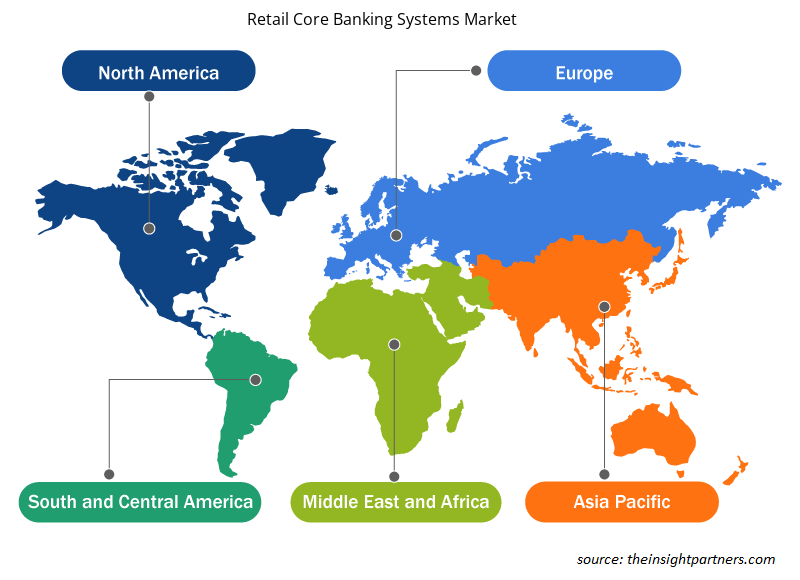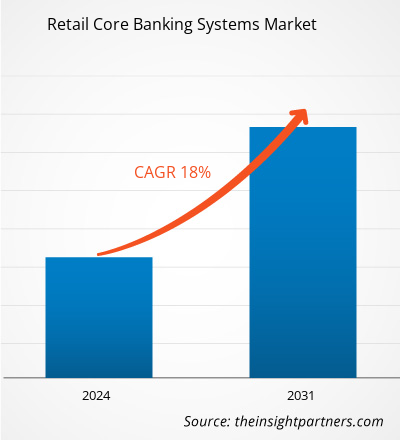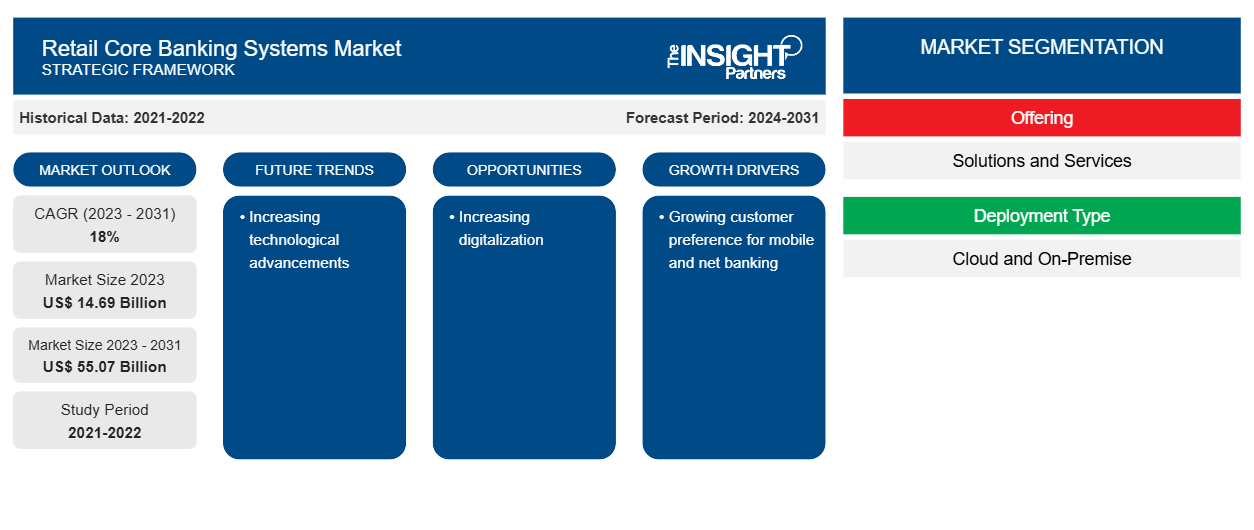リテールコアバンキングシステム市場規模は、2023年の146億9,000万米ドルから2031年には550億7,000万米ドルに達すると予測されています。市場は2023年から2031年にかけて18%のCAGRを記録すると予想されています。CAGR of 18% in 2023–2031. 技術の進歩は今後も小売コアバンキングシステム市場の主要なトレンドであり続けると思われます。
小売コアバンキングシステム市場分析
銀行システムが最先端のテクノロジーを迅速に採用しているため、リテール コア バンキング ソリューションのグローバル市場は大幅に成長しており、今後も成長が見込まれています。コア バンキング システムとは、顧客が世界中のどこからでもさまざまな金融サービスにアクセスし、自分の口座を監視できるようにする銀行支店のネットワークです。
さらに、銀行やフィンテック企業は、それぞれの事業の持続可能性と成長を高めるために情報技術 (IT) を活用しています。コアバンキング技術は、顧客を満足させ、銀行取引のパフォーマンスを向上させ、変化するビジネスニーズに迅速に適応する方法を提供します。また、技術によって、銀行はプロセスを合理化し、遅延を減らし、報告とコンプライアンスを改善し、顧客に簡単なアクセスを提供することもできます。FinTech companies to enhance the sustainability and growth of their respective businesses. Core
小売コアバンキングシステム市場の概要
リテール コア バンキング システムは、個人または消費者向け銀行業務のデジタル チャネルを介して顧客に優れたサービスを提供するために必要なツールを銀行に提供します。顧客がクレジットにアクセスし、安全に資金を移動できるようにすることで、これらのテクノロジは顧客の資金管理を改善します。リテール バンキング システムの使用により、銀行は低コストで資本を調達し、安定した顧客基盤を確立し、効果的な顧客関係管理 (CRM) を維持することができます。これらすべてがリテール コア バンキング システムの市場を牽引すると予想されます。さらに、モバイル バンキングとネット バンキングに対する消費者の需要の高まりが、市場の拡大を支えています。CRM), all of which are anticipated to drive the market for retail core banking systems. Additionally, the growing consumer demand for mobile and net banking is supporting the market's expansion.
要件に合わせてレポートをカスタマイズする
このレポートの一部、国レベルの分析、Excelデータパックなど、あらゆるレポートを無料でカスタマイズできます。また、スタートアップや大学向けのお得なオファーや割引もご利用いただけます。
-
このレポートの主要な市場動向を入手してください。この無料サンプルには、市場動向から見積もりや予測に至るまでのデータ分析が含まれます。
小売コアバンキングシステムの市場推進要因と機会
モバイルバンキングとネットバンキングに対する顧客の嗜好の高まり
個人向けコアバンキングソリューション市場の今後の成長は、モバイルバンキングやネットバンキングに対する顧客の需要の高まりに大きく起因するでしょう。モバイルバンキングを利用すると、顧客はスマートフォンやタブレットなどのポータブルデバイスを使用して銀行口座にアクセスして管理したり、その他の金融業務を実行したりできます。「ネットバンキング」と呼ばれる銀行サービスにより、ユーザーはさまざまな銀行リソースにアクセスし、インターネット経由で金融取引を実行できます。よりシームレスなチャネル操作を保証するために、個人向けコアバンキングソリューションは、ネットバンキングサービスと銀行の従来の運用チャネルをリンクするために使用されます。
デジタル化の進展Digitalization
リテール コア バンキング ソリューション市場の今後の成長は、主に銀行業界のデジタル化の進展によるものです。銀行、金融サービス、保険 (BFSI) 部門では、「デジタル トランスフォーメーション」とは、デジタル技術と戦略を統合して顧客体験を向上させ、ビジネス プロセスを合理化し、業界の競争力を高めることを指します。マルチチャネル バンキングはリテール コア バンキング ソリューションによってサポートされており、ユーザーは ATM、モバイル アプリ、オンライン バンキングなど、さまざまなチャネルを介してサービスにアクセスできます。したがって、予測期間中、デジタル化の進展により、リテール コア バンキング システム市場のプレーヤーに新たな機会がもたらされると予想されます。digitalization. In the banking, financial services, and insurance (BFSI) sector, "digital transformation" refers to the integration of digital technologies and tactics to improve client experiences, streamline business processes, and boost industry competitiveness. Multi-channel banking is supported by retail core banking solutions, giving users access to services via a variety of channels, including ATMs, digitalization is anticipated to present new opportunities for the retail core banking systems market players during the forecast period.
小売コアバンキングシステム市場レポートのセグメンテーション分析
小売コアバンキングシステム市場分析の導出に貢献した主要なセグメントは、提供と展開のタイプです。
提供内容(ソリューションとサービス)、導入タイプ(クラウドとオンプレミス)および地域
- 提供内容に基づいて、小売コアバンキングシステム市場はソリューションとサービスに分かれています。
- 展開タイプ別に見ると、市場はクラウドとオンプレミスに分かれています。2023年にはクラウドセグメントが市場で最大のシェアを占めました。
地域別小売コアバンキングシステム市場シェア分析
リテール コア バンキング システム市場レポートの地理的範囲は、主に北米、アジア太平洋、ヨーロッパ、中東およびアフリカ、南米/中南米の 5 つの地域に分かれています。収益の面では、北米がリテール コア バンキング システム市場で最大のシェアを占めています。コア バンキング ソリューションの継続的な技術進歩と、Canadian Western Bank や HSBC Holdings plc などの大手企業による採用により、予測期間中、優位性が続くと予想されます。
小売コアバンキングシステム市場の地域別洞察
予測期間を通じて小売コアバンキングシステム市場に影響を与える地域的な傾向と要因は、Insight Partners のアナリストによって徹底的に説明されています。このセクションでは、北米、ヨーロッパ、アジア太平洋、中東およびアフリカ、南米および中米にわたる小売コアバンキングシステム市場のセグメントと地理についても説明します。

- 小売コアバンキングシステム市場の地域別データを入手
小売コアバンキングシステム市場レポートの範囲
| レポート属性 | 詳細 |
|---|---|
| 2023年の市場規模 | 146.9億米ドル |
| 2031年までの市場規模 | 550.7億米ドル |
| 世界のCAGR(2023年~2031年) | 18% |
| 履歴データ | 2021-2022 |
| 予測期間 | 2024-2031 |
| 対象セグメント |
提供することで
|
| 対象地域と国 |
北米
|
| 市場リーダーと主要企業プロフィール |
|
市場プレーヤーの密度:ビジネスダイナミクスへの影響を理解する
小売コア バンキング システム市場は、消費者の嗜好の変化、技術の進歩、製品の利点に対する認識の高まりなどの要因により、エンド ユーザーの需要が高まり、急速に成長しています。需要が高まるにつれて、企業は提供内容を拡大し、消費者のニーズを満たすために革新し、新たなトレンドを活用し、市場の成長をさらに促進しています。
市場プレーヤー密度とは、特定の市場または業界内で活動している企業または会社の分布を指します。これは、特定の市場スペースに、その市場規模または総市場価値に対してどれだけの競合相手 (市場プレーヤー) が存在するかを示します。
小売コアバンキングシステム市場で事業を展開している主要企業は次のとおりです。
- オラクル株式会社
- SAP SE
- タタ・コンサルタンシー・サービシズ・リミテッド
- フィナストラインターナショナルリミテッド
- キャピタルバンキングソリューション
- エッジバーブシステムズリミテッド
免責事項:上記の企業は、特定の順序でランク付けされていません。

- 小売コアバンキングシステム市場のトップキープレーヤーの概要を入手
個人向けコアバンキングシステムの市場ニュースと最近の動向
小売コア バンキング システム市場は、主要な企業出版物、協会データ、データベースなどの一次調査と二次調査後の定性的および定量的データを収集することで評価されます。以下は、音声言語障害と戦略の市場における動向の一覧です。
- 2023年4月、Oracle FSは、OracleのFLEXCUBE実装パートナーであるProfinchと連携して、エチオピアに拠点を置くOMO Bankのコアバンキングソフトウェアを更新し、新しいマネーロンダリング防止(AML)および詐欺防止テクノロジーを組み込みました。
(出典: Oracle、プレスリリース)
- 2023年10月、フィンテックのスタートアップ企業であるSopra Banking Software(SBS)が、最先端のSoftware-as-a-Service(SaaS)コアバンキングプラットフォームを導入しました。このプラットフォームは、リアルタイムで動作するAI対応の完全クラウドネイティブソリューションです。
小売コアバンキングシステム市場レポートの対象範囲と成果物
「小売コアバンキングシステム市場規模と予測(2021〜2031年)」レポートでは、以下の分野をカバーする市場の詳細な分析を提供しています。
- 対象範囲に含まれるすべての主要市場セグメントの世界、地域、国レベルでの市場規模と予測
- 市場の動向(推進要因、制約、主要な機会など)
- 今後の主な動向
- 詳細なPEST/ポーターの5つの力とSWOT分析
- 主要な市場動向、主要プレーヤー、規制、最近の市場動向を網羅した世界および地域の市場分析
- 市場集中、ヒートマップ分析、主要プレーヤー、最近の動向を網羅した業界の状況と競争分析
- 詳細な企業プロフィール
- 過去2年間の分析、基準年、CAGRによる予測(7年間)
- PEST分析とSWOT分析
- 市場規模価値/数量 - 世界、地域、国
- 業界と競争環境
- Excel データセット
最新レポート
お客様の声
購入理由
- 情報に基づいた意思決定
- 市場動向の理解
- 競合分析
- 顧客インサイト
- 市場予測
- リスク軽減
- 戦略計画
- 投資の正当性
- 新興市場の特定
- マーケティング戦略の強化
- 業務効率の向上
- 規制動向への対応























 無料サンプルを入手 - 小売コアバンキングシステム市場
無料サンプルを入手 - 小売コアバンキングシステム市場